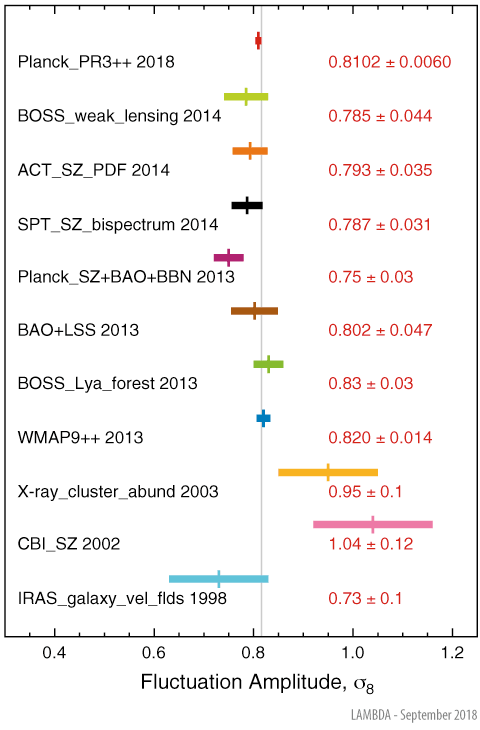

FluctuationsWhile Ωm specifies the mean density of matter in the present day universe, σ8 specifies how that matter is distributed (clumped) at a fiducial scale length. More specifically, the amplitude of the matter power spectrum can be parameterized in terms of the amplitude of the linear matter fluctuations, σ8, defined as the rms of the z=0 density perturbations on scales of 8h-1 Mpc (e.g. Planck XX 2014, Addison, Hinshaw & Halpern 2013). Galaxy surveys play a key role in determinations of σ8 which probe redshifts and scales different from that provided by CMB measurements. Extraction of mass distribution information is possible through the use of cluster counts, weak lensing, positional fluctuations in Lyα forest flux (e.g., Slosar et al. 2013), velocity dispersions, and SZ measurements. Aside from observational systematics particular to each technique, in some cases there are degeneracies between σ8 and other cosmological parameters which must be broken before a value may be obtained. Abundances of clusters may be used to determine the mass function, if an appropriately calibrated scaling relation exists between cluster observables (e.g. X-ray temperature, luminosity, integrated SZ signal) and cluster mass. The mass function may then be modeled, but a strong degeneracy exists between σ8 and Ωm at low redshift (Huterer & White 2002, Spergel et al. 2003, Vikhlinin et al. 2009). Studies of this nature included in the figure are labeled "X-ray cluster abundances" (Bahcall & Bode 2003) and "Planck SZ + BAO + BBN" (Planck XX 2014). Bahcall & Bode (2003) break this degeneracy through the use of higher redshift clusters; the Planck SZ study used external datasets as their means. Determinations of σ8 based on galaxy velocity fields are also strongly degenerate with Ωm. Spergel et al. (2003) combined the IRAS galaxy velocity measurements of Willick & Strauss (1998) with the IRAS fluctuation amplitude of Fisher et al. (1994) to obtain a value for σ8 Ωm0.6. Their determination of σ8, shown in the figure as "IRAS galaxy vel flds", relies on the WMAP value for Ωm. SZ measurements have provided a venue for avoiding some of the commonly encountered parameter degeneracies through the use of effects which are more difficult to observe, but are sensitive to σ8χ, where χ > 6.Komatsu & Seljak (2002) demonstrated that the SZ angular power spectrum scales as σ86 Ωbh2, and derived an early result using CBI data. More recent determinations from SPT and ACT have utilized effects sensitive to even higher powers of σ8: the thermal SZ (tSZ) bispectrum (Crawford et al. 2014) on small angular scales (1000 < ι < 10000) and the one-point probability distribution function (PDF) of the tSZ decrement (Hill et al. 2014). Determinations of σ8 from CMB power spectrum modeling are represented in the figure by the most recent results of Planck and WMAP, which are combined with data from ACT, SPT, BAO and other data. The Planck and WMAP values are in good agreement with each other. Comments in the recent literature have surfaced concerning slight tension between values derived from CMB data versus those derived from lower redshift sources. The Planck collaboration found tension between their 2013 SZ cluster count results and their 2013 CMB results, citing modeling of the cluster gas physics as the key uncertainty in the SZ analysis. Hill et al. (2014) briefly review recent results and note a preference for slightly lower σ8 from tSZ and galaxy clustering measurements compared to those derived from the primordial CMB data. This slight preference can be seen in the figure when regarding determinations dating from 2013 and later (if one disregards the BOSS Lyα forest result). It remains to be seen if this is real or the result of imperfect understanding of systematics or gastrophysics.  Image Credit: NASA / LAMBDA Archive Team The amplitude of the primordial matter power spectrum is parameterized by σ8. This provides an important constraint on clustering of matter (CDM dominated) and the formation of structure.
As with Ωm, methods using observations of galaxy clusters (abundances, velocity fields, WL) can suffer from degeneracies with other parameters. Alternate methods make use of the SZ effect.
Recent determinations of σ8 using these lower-redshift data show a slight preference for lower values than those from CMB determinations. It is too early to definitively invoke interesting cosmological physics as the cause, since underlying systematics may still be present. The gray vertical line, representing the weighted average of
WMAP and Planck data points, is positioned at σ8 = 0.8163.
Contributed by the NASA / LAMBDA Archive Team. |

